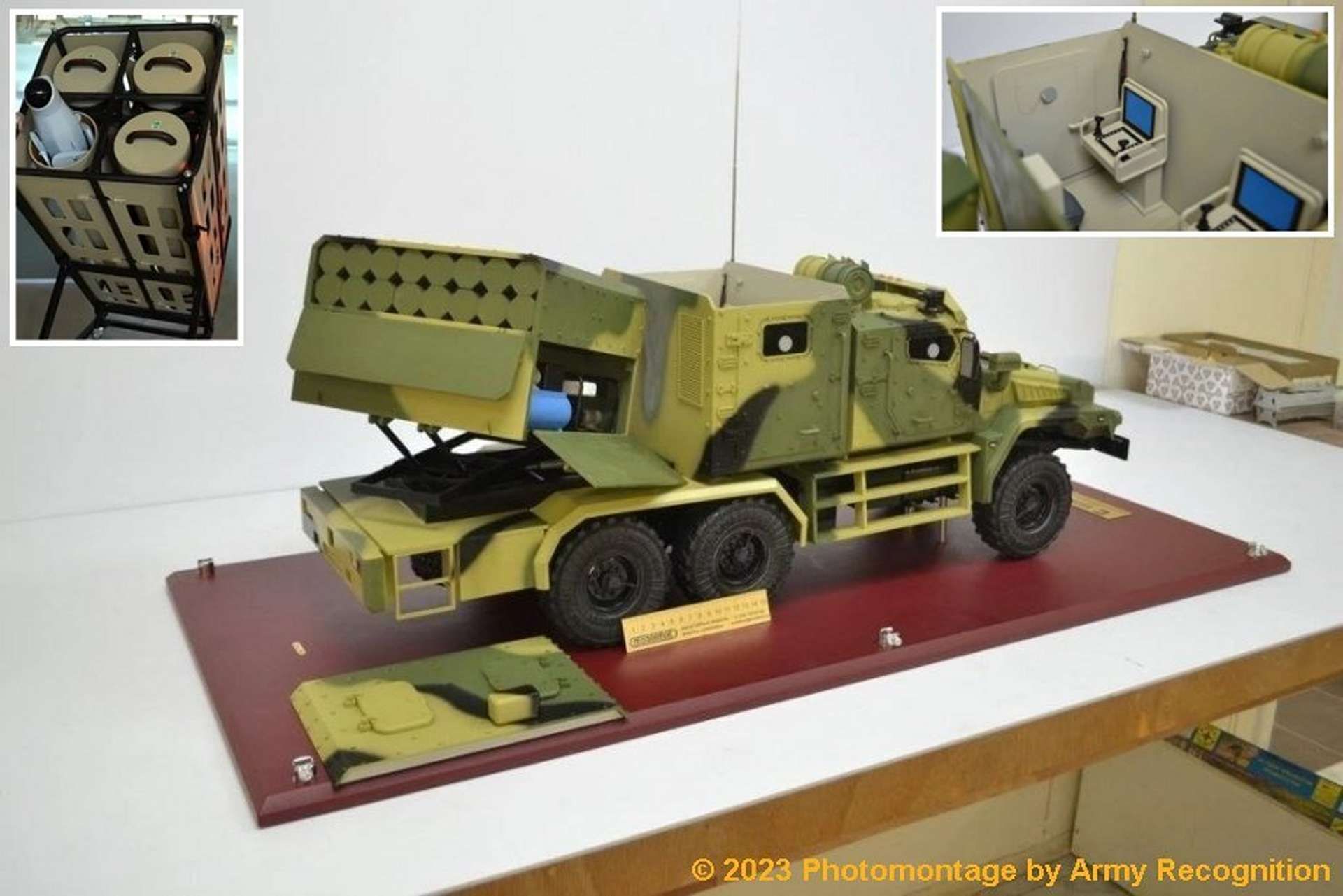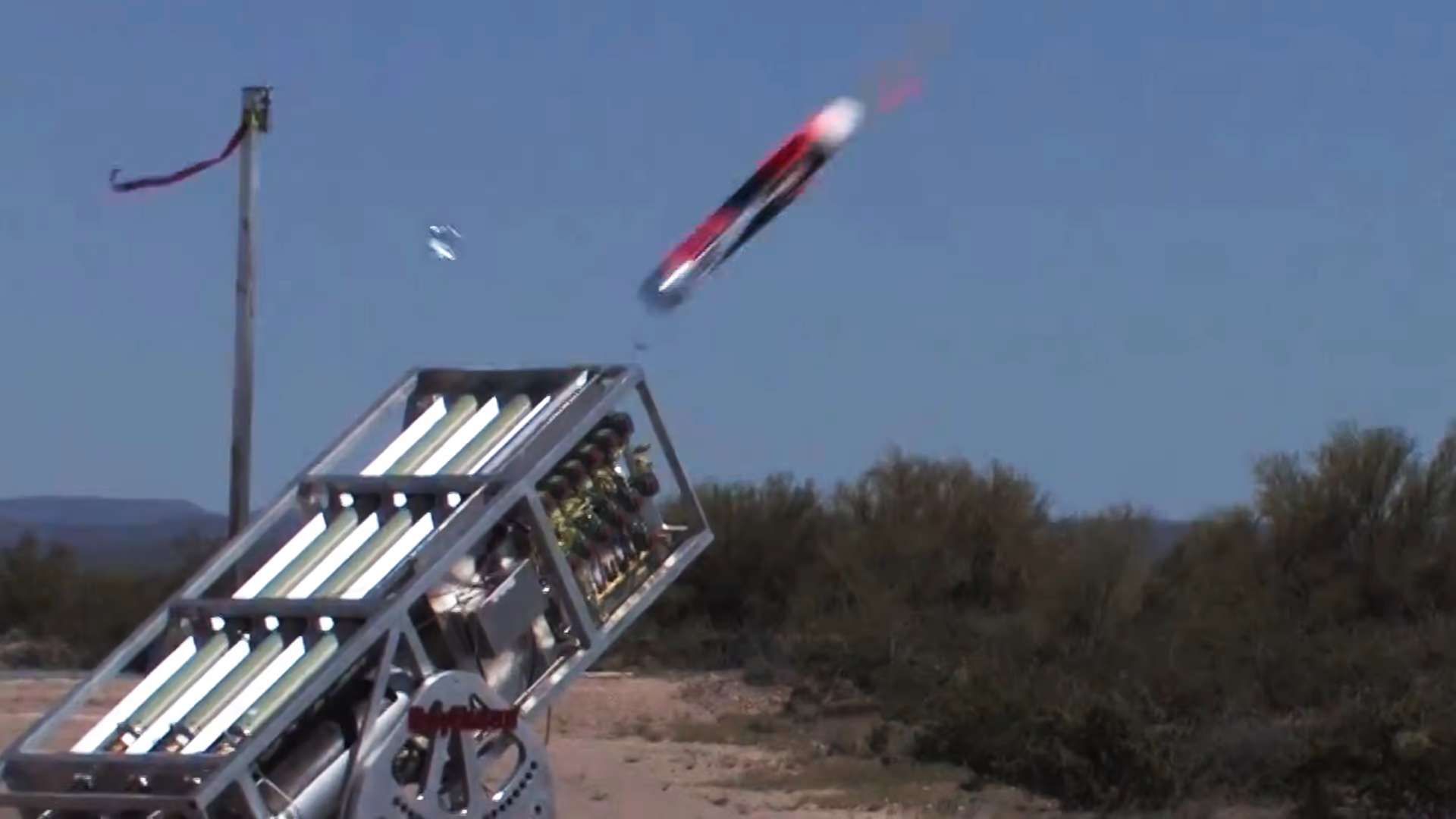Breaking News
South Korea to combine new Drone Multiple Launcher with Chunmoo MLRS and L-SAM systems.
At the Korea Army International Defense Exhibition (KADEX) 2024, the South Korean Agency for Defense Development (ADD), in collaboration with Hanwha Aerospace, presented the Drone Multiple Launcher. This system is designed to modularize launch sites, featuring multiple launching pads capable of deploying several small-sized drones and rail-type launchpads for medium-sized drones.
Follow Army Recognition on Google News at this link

Based on an unmanned search vehicle platform, the Drone Multiple Launcher could launch up to 10 drones. (Picture source: Army Recognition)
Based on an unmanned search vehicle platform, the launcher enables mission-specific operations (including attack and surveillance) tailored to various targets. Operated remotely under the control of a ground control vehicle, the system can simultaneously deploy drones of different sizes and shapes. It can also be integrated with existing platforms such as the Chunmoo Multiple Rocket Launch System (MRLS) and the L-SAM long-range surface-to-air missile system.
In a parallel development, Korea Aerospace Industries (KAI) and Kia Motors also introduced a new 4x4 modular drone carrier vehicle. This vehicle combines the Kia K151 Raycolt with KAI's Compact & Multi-Mission Modular UAV (CMMAV). Reflecting a global trend toward enhancing unmanned aerial systems, this collaboration aims to boost the capabilities of drones for a range of military applications.
The CMMAV is a modular UAV designed for multiple missions, characterized by its ability to quickly change payloads based on specific requirements. Its versatility allows it to perform intelligence, surveillance, reconnaissance (ISR), communications relay, and strike missions. Designed for canister launch, the CMMAV is suitable for deployment by ground, naval, and air forces and incorporates swarm technology for coordinated drone operations.
The system features tube-based launches, precision flight controls, and an integrated Command, Control, Communications, Computers, and Intelligence (C4S) fire control system. While specific performance metrics such as altitude, speed, and endurance have not been detailed, the CMMAV's multi-modular payload capacity is expected to support a range of military functions.

This new drone carrier vehicle combines the Kia K151 Raycolt with KAI's Compact & Multi-Mission Modular UAV (CMMAV) and has the capability to launch up to 20 drones. (Picture source: Army Recognition)
These two South Korean novelties mirror similar developments in other countries, to combine drone swarms, multiple launch systems, and vehicles already in service within their national armed forces.
In Russia, a Multiple Launch Drone System (MLDS) is reportedly under development, based on the 6x6 Kamaz 5350 Patrol armored vehicle. This system is designed to launch Lancet kamikaze drones via 16 transport-launch containers, allowing for the rapid deployment of up to 64 drones using a tube-based method instead of the traditional catapult launch system. The Lancet drones, developed by Zala Aero Group, are equipped with optical-electronic and TV guidance systems, ensuring precise control during the final flight phase. They have a range of 40 kilometers, a takeoff weight of 12 kilograms, and can reach speeds of up to 300 kilometers per hour. The drones can carry various types of warheads, including high-explosive, thermobaric, and high-explosive anti-tank (HEAT), making them versatile tools for the Russian military.
The MLDS prototype includes dual UAV operator control stations and utilizes swarm technology for its drones. The Lancet drones can share intelligence, autonomously identify targets, and conduct coordinated attacks. The system's layout features an armored cabin, followed by an operator center, and the launcher housing the drones. This configuration facilitates drone launches from various locations and swift repositioning, enhancing the system's potential to engage a greater number of objectives.

The MLDS prototype, based on the 6x6 Kamaz 5350 Patrol armored vehicle, is designed to launch Lancet kamikaze drones via 16 transport-launch containers, allowing for the rapid deployment of up to 64 drones. (Picture source: Russian social media)
Similarly, China has been investing heavily in swarm drone technologies. The People's Liberation Army (PLA) has demonstrated swarm tactics using FPV (First Person View) kamikaze drones, designed to overwhelm enemy defenses by coordinating attacks on ground units or infrastructure. In trials, modified Dongfeng Mengshi 6×6 CTL181A armored vehicles have been fitted with 48-tube multiple UAV launchers. These drones can be deployed individually or in swarms and are capable of autonomously maneuvering to their targets. The PLA has showcased the ability to launch drones even while on the move, integrating the system with various platforms to enhance battlefield capabilities.
In the United States, advancements are also underway. The Navy's Low-Cost UAV Swarming Technology (LOCUST) program has developed launchers capable of firing swarms of drones that can jam enemy communications and draw enemy fire. These launchers can tube-launch 31 drones in just 40 seconds, with the drones capable of flying autonomously or being manually controlled. The drones are expendable, costing approximately $15,000 each, and are intended for use in dangerous situations.
The Air Force Special Operations Command (AFSOC) is working on the Air-Launched Effects (A2E) program, which integrates drone swarming with larger platforms like the MQ-9 Reaper to deploy smaller UAVs mid-flight. These drones can carry out multiple roles, including ISR and strike missions, with the goal of controlling large formations of drones using a single crew.

In trials, the Chinese People's Liberation Army (PLA) modified Dongfeng Mengshi 6×6 CTL181A armored vehicles which have been fitted with 48-tube multiple UAV launchers. (Picture source: CETC)
In Israel, SpearUAV has introduced the MCL Viper system, a Multi-Canister Launcher designed to deploy multiple drones from military vehicles without exposing operators to harm. The system integrates seamlessly with various platforms, offering capabilities in intelligence, surveillance, target acquisition, reconnaissance (ISTAR), and electronic warfare. Its versatility allows tactical units to maintain high maneuverability and real-time response, making it a valuable tool on the battlefield.
Finally, German company Rheinmetall has unveiled a containerized launcher concept for Hero family loitering munitions, also known as kamikaze drones, from Israeli firm UVision. The modified shipping container with 126 launch cells opens up operational possibilities on land and at sea, allowing for the deployment of drones in various scenarios.
The rapid progression of drone swarm technologies and multiple drone launcher systems is reshaping modern military tactics by providing enhanced operational capabilities. Traditional air defense systems may not be able to knock down incoming drones fast enough, and jamming may not be effective against autonomous drones that do not rely on direct operator control or GPS navigation. This has led to advancements in counter-UAS systems and the development of new defensive measures, such as deploying counter-swarms to outwit and outfight attacking drones.

The US Navy's Low-Cost UAV Swarming Technology (LOCUST) program has developed launchers capable of launching 31 drones in just 40 seconds, with the drones capable of flying autonomously or being manually controlled. (Picture source: US DoD)


























